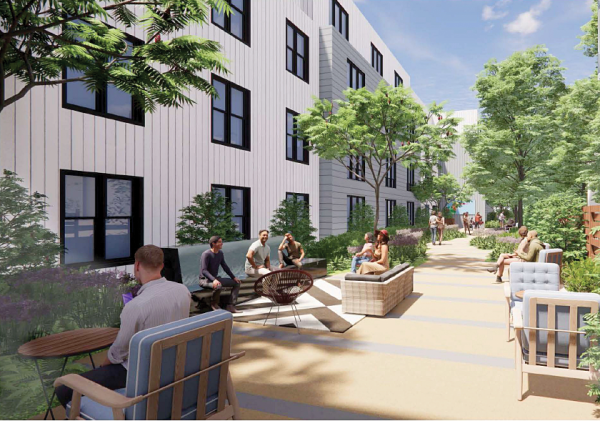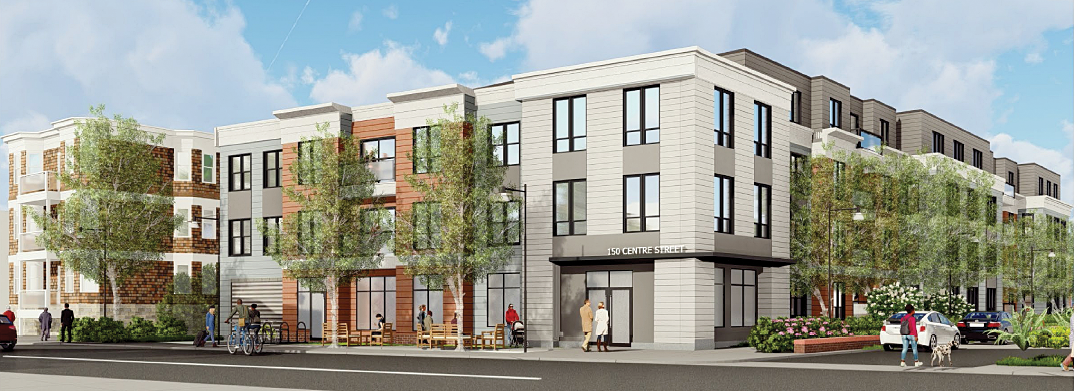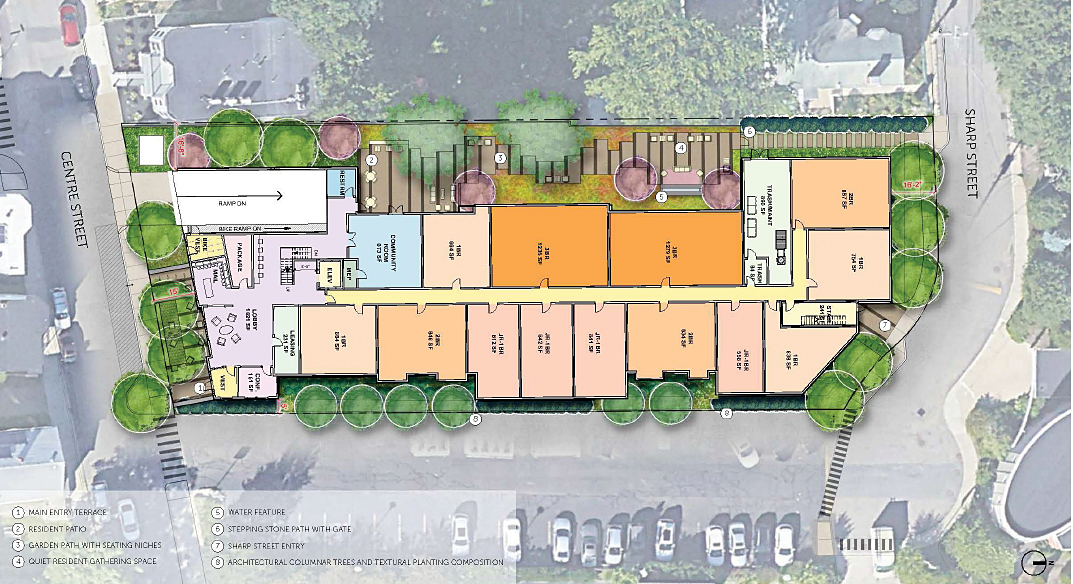October 11, 2023

A rendering depicts the latest design for the Trinity-Shawmut project.
Image courtesy ICON Architecture
Developers trying to get the city’s approval for transit-oriented housing near Shawmut Station showed off their latest plans last week, scoring points with supporters but making little headway against neighborhood opposition.
At an online meeting arranged for Oct. 3 by the Boston Planning and Development Agency (BPDA), members of the Impact Advisory Group (IAG) responded to changes in the plan presented by Michael Lozano, vice president of development for Trinity Financial, a company headed by a Dorchester resident, Jim Keefe.
The latest plan shows a four-story building that appears less boxy and offers more affordability. Other changes include 25 parking spaces at basement level, along with “better facilities” for bike storage. Trinity had originally proposed 39 parking spaces, but these were later eliminated at the city’s request.
Under the new plan, all 72 units at the development, known as 150 Centre Street at Shawmut, would be income restricted. The total was reduced from an earlier 74 units, but with an additional four units having two or three bedrooms. Forty-nine units would be studio or one-bedroom apartments.
The number of units affordable to renters at or below 30 percent of the Area Median Income ($35,640 for a household of two, according to the BPDA) was doubled, from 8 to 16. Instead of 29 market units under the previous plan, there would be 20 units affordable up to 120 percent of the AMI ($142,560 for a household of two). There would be fewer units for incomes up to 60 percent of the AMI, an addition of 8 units at 50 percent ($59,400 for a household of two), and more units at 80 percent ($95,040).
IAG member and St. Mark’s Area resident Carolyn Chou said she was “excited” to see more deep affordability and the number of units with at least two bedrooms.
“There’s so much unaffordable development coming,” she said, “and I hope we can really support affordable development like this that is going to keep our neighborhood the diverse place we want it to be.”
An IAG member from the Codman Square area, Mike Prokosch, credited Trinity with making “a lot of improvements that respond to input they’ve gotten.”
As described by Lozano, design changes to the façade opposite the Shawmut Station plaza would have more indentation, combined with more trees, to make the exterior “less boxy” and “break down the scale.” The new plan positions the building farther from adjacent properties on Centre and Allston streets, but with the other side shifting to only five feet from the parking lot owned by another neighbor, the Epiphany School.
Some abutters on the IAG raised concerns about the change of position—and the minimal change in scale. Andrew Saxe, an IAG member from Allston Street, said the updates were only “tweaks. It’s the same size. The mass has not changed at all. The shadow impacts are not going to change at all.”


A rendering and site plan of the 150 Centre Street at Shawmut Station proposal as shown in a presentation to the project’s Impact Advisory Group last week. Images courtesy ICON Architecture
Wellesley Park resident Domenic Accetta flagged an open-air courtyard for the building’s residents—which Lozano called “more substantial” — as a potential problem for its neighbors.
“It’s just a box with a lot of windows, and it’s a big box with a lot of windows,” said Accetta, “in a neighborhood that doesn’t have a big box with a lot of windows. It’s a neighborhood that has homes, with neighbors. And that’s what we’re still trying to maintain in this development.”
Another supporter of the plan on the IAG, Lynn Sanders, responded soon after: “This is a larger building than things that are in the neighborhood, but it is a home to many neighbors, and like the other homes in the neighborhood. And I would be excited to welcome many more neighbors because of this building.”
Other opponents from the neighborhood warned that the building could, at times, worsen traffic congestion on Centre Street and conflict with any potential expansion of the Epiphany School into an area including the part of its property currently used for parking.
Speaking four days after the meeting, Epiphany’s Head of School, John H. Finley IV, said the parking area would become an “unbuildable lot.”
He drew attention to the more than one thousand signatures in support of an alternative development plan, in the “Build Together: Shawmut” campaign by the Melville-Park Neighborhood Association, St. Mark’s Area Civic Association, and the Codman Square Neighborhood Council. According to Finley, the signatures were gathered near Shawmut Station.
“’Build Together’ wants transit-oriented, affordable housing,” he said. “What ‘Build Together’ wants is family-sized units, with a path to home ownership that’s truly affordable, that can help families stay in this community.”
The “Build Together” website shows a concept for a three-story wood frame building, with 22 units of housing, near the corner of Centre Street and Clementine Park. There would also be room for expansion of the Epiphany School. The projects would require a consolidation of lots, including the four parcels currently under purchase and sale agreement between Trinity and owners of the Fitzpatrick Brothers Auto Body shop.
As Lozano mentioned in his presentation, Trinity’s plan envisions access provided by a pre-existing easement. Saxe warned him that the terms of the easement could pose a legal hurdle and said there could also be regulatory hurdles connected with scale of development and historic character in the area’s preservation overlay districts.
Accetta told Lozano to get more reaction to the update from local neighborhood groups, and to meet with Epiphany’s Finley. “If you think this is actually an improvement, then you need to go back to all of those groups and find out what they think,” said Accetta.
Lozano said he would be willing to meet with Finley in the “near future,” and added later, “We’re happy to go to the neighborhood associations.”
Trinity and groups supporting the “Build Together” concept have been trying to advance ideas for redeveloping the site near Shawmut Station since 2016.
Toward the end of the IAG discussion, Jenn Cartee, until recently, the executive Director of Greater Ashmont Main Street, spoke in support of the plan and lamented, “I think the travesty is that it’s been eight years to get to this point, and the amount of process and the amount of complicatedness of getting anything like this done in Boston.”
Doug Shaheen, a former resident of Cheverus Road off Dorchester Avenue, blamed the amount of new development along Dorchester Avenue that feature more units than parking spaces. He said he recently moved out of the neighborhood because it was getting harder to find a place to park, and he argued against Trinity’s plan.
“I’m not looking at this as a ‘NIMBY – ‘Not In My Backyard,’” he said. “To me, it’s a ‘NIABY’– ‘Not In Anybody’s Backyard.’ Nobody should have a building this size built on a side street in a residential area.”


